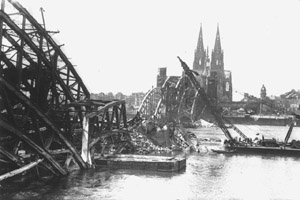| |
Epoch II
Introduction
The rise of the long-distance railroad traffic
A new era, a new generation of coaches
Standard design locomotives
Service on a high level, the Mitropa
The rise of a trainlegend
A new numbering scheme for passenger cars
Beginning of the modern age, electric locomotives
A new idea, the SVT
The competitor of the SVT, the Henschel-Wegmann-Zug
Result of renewal: the Schürzenwagen
The temporarily ending
The temporarily ending
At the end of the thirties you could hardly found no similar railroad network as in Germany, this was the opinion of the American press at those days. The German railroad network contained at the end of the thirties around 53.000 kilometer of railtrack, and there worked 700.000 people at the DRG. And indeed the DRG was in comparison with other railway companies in countries like France and Great Britain better organised, organizational as well as physical. The DRG was one of the few railway companies in the world that served a whole country, because in Great Britain there was the famous "LMS" and the "Great Western" and in France there was the "Nord" and "Etat".
In 1934 the DRG was put under government control by the national socialistic dictators which took the power on 30 January 1933. From that day the DRG wasn't anymore the independent company. As a result of these takeover it was over with the innovative and technical highstanding developments of the DRG. The DRG was part of the department of transportation. And in official documents they dropped the name DRG and used the new name Deutsche Reichsbahn. From 1936 the DRG was calling itself Deutsche Reichsbahn too. The DRG was used for propaganda purposes by the Nazi regime. Locomotives and coaches were equiped with swastikas just as employee clothing. The DRG was degenerated to an instrument of the regime. When Germany declared the war to Europe on 1 September 1939, the DRG was used to transported many soldiers and equipment to the front. There were 13.000 locomotives built until 1944 only to be used for the German army. The blackest page of the DRG history was the application of the DRG in the Holocaust. There are more than 3 million Jews people transported to the concentration camps.
 | | The Hohenzollernbrücke in Cologne after the second world war |
The first trains which were abandoned from the timetable at the beginning of the second world war were the international trains. Soon followed the domestic train services. During the war there was no need for long-distance travel. In 1943 the regime declared the total war. Under the slogan "Räder müssen rollen für den Sieg" (wheels must be running for the victory) the last rolling stock of the DRG was used and everything what was running was used for the war. The passenger trains which were still running, mostly Eilzuge and Personenzuge were further reduced under the slogan "Erst siegen, dann reisen" (first the victory, then travel). The second world war became the blackest page of the history of the DRG and the German Railways.
Short after the capitulation of the Nazi regime, Germany was divided into four occupation zones. An American, a French, a Britisch and a Russian occupation zone. At that time the Reichsbahn made the balance of the war. Many stations, shunting yards, railway lines and many rolling stock was ruined and destroyed by bombings. The once so important railway company with it's high technical standards and innovations was degenerated to a mess.
| Das große typenbuch deutscher Lokomotiven |
| Manfred Weisbrod, Dieter Bäzold, Horst J. Obermayer |
| Transpress, Berlin, 1992 |
| |
| Die Einheits-Personen und Gepäckwagen der Deutsche Reichsbahn, Bauarten 1921-1931 |
| Joachim Deppmeyer |
| Franckh'sche Verlagshandlung, Stuttgart, 1982 |
| |
| Eisenbahn-Fahrzeug-Archiv 6.1,Reisezugwagen-Archiv 1 |
| Peter Wagner, Sigrid Wagner |
| Transpress VEB verlag, Berlin, 1989 |
| |
| ICE |
| Bahn Special 9703 |
| GeraNova, München, 1997 |
| |
| Eisenbahn Fahrzeug Katalog, Band 3 Wagen |
| |
| GeraNova, München, |
| |
| Eisenbahn Fahrzeug Katalog, Band 7 Dieseltriebfahrzeuge |
| |
| GeraNova, München, |
| |
|
